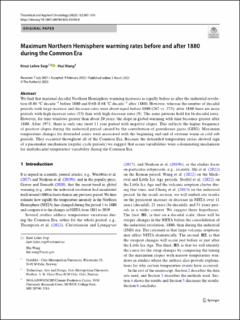| dc.contributor.author | Seip, Knut Lehre | |
| dc.contributor.author | Wang, Hui | |
| dc.date.accessioned | 2023-06-14T07:36:57Z | |
| dc.date.available | 2023-06-14T07:36:57Z | |
| dc.date.created | 2023-02-19T11:55:10Z | |
| dc.date.issued | 2023 | |
| dc.identifier.issn | 0177-798X | |
| dc.identifier.issn | 1434-4483 | |
| dc.identifier.uri | https://hdl.handle.net/11250/3071271 | |
| dc.description.abstract | We find that maximal decadal Northern Hemisphere warming increases as rapidly before as after the industrial revolution (0.86 °C decade−1 before 1880 and 0.60–0.68 °C decade−1 after 1880). However, whereas the number of decadal periods with large increase and decrease rates were about equal before 1880 (267 vs. 273), after 1880 there are more periods with high increase rates (35) than with high decrease rates (9). The same patterns hold for bi-decadal rates. However, for time windows greater than about 20 years, the slope in global warming with time becomes greater after 1880. After 1971, there is only one short 11 year period with negative slopes. This reflects the higher frequency of positive slopes during the industrial period caused by the contribution of greenhouse gases (GHG). Maximum temperature changes for detrended series were associated with the beginning and end of extreme warm or cold sub periods. They occurred throughout all of the Common Era. Because the detrended temperature series showed sign of a pacemaker mechanism (regular cycle periods) we suggest that ocean variabilities were a dominating mechanism for multidecadal temperature variability during the Common Era. | en_US |
| dc.language.iso | eng | en_US |
| dc.publisher | Springer | en_US |
| dc.relation.ispartofseries | Theoretical and Applied Climatology; | |
| dc.rights | Navngivelse 4.0 Internasjonal | * |
| dc.rights.uri | http://creativecommons.org/licenses/by/4.0/deed.no | * |
| dc.title | Maximum Northern Hemisphere warming rates before and after 1880 during the Common Era | en_US |
| dc.type | Peer reviewed | en_US |
| dc.type | Journal article | en_US |
| dc.description.version | publishedVersion | en_US |
| cristin.ispublished | false | |
| cristin.fulltext | postprint | |
| cristin.fulltext | original | |
| cristin.qualitycode | 1 | |
| dc.identifier.doi | https://doi.org/10.1007/s00704-023-04398-0 | |
| dc.identifier.cristin | 2127277 | |
| dc.source.journal | Theoretical and Applied Climatology | en_US |

